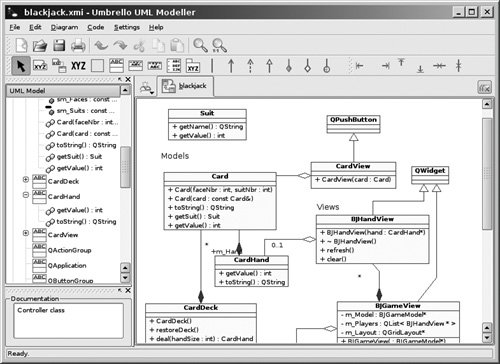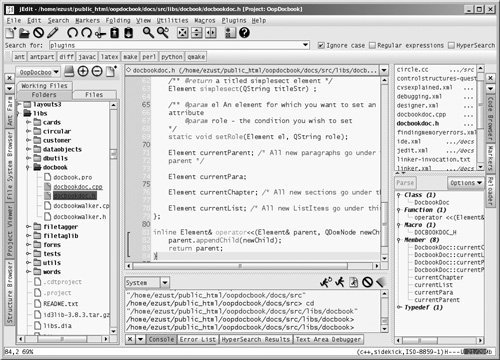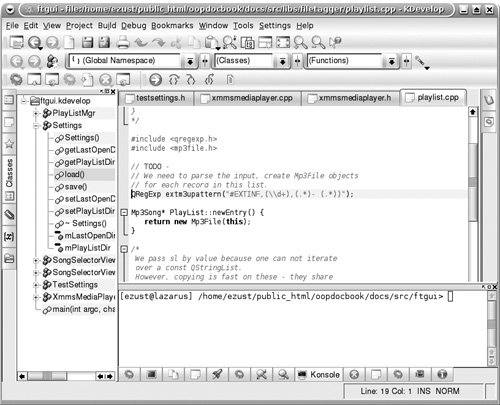Section C.5. Open-Source IDEs and Development Tools
C 5 Open Source IDEs and Development Tools
It is not practical to do object-oriented development with an ordinary text editor. Object-oriented development involves working with many classes and many more files (headers and sources). Writing code in an edit window is just a small part of the development process. A good programmers editor or IDE (integrated development environment) should support many of the following features:
- Tree-like structured navigation to object/members in any file
- Refactoring assistance for moving/renaming members
- Integrated debugger
- Context-sensitive help linked to API documentation
- A built-in command-line shell window so you can run programs without leaving your environment
- A project manager to help manage groups and subgroups of related files
- Editing modes in other programming languages
- Easy keyboard customizationthe ability to make any keystroke perform any task (cursor movement especially, but also window movement)
- An open plug-in architecture so you can add other components
- Integration with a version-control facility is desirable, especially in windows environments. Look for CVS,[6] Subversion,[7] or Darcs[8].
[6] https://www.cvshome.org/
[7] http://subversion.tigris.org/
[8] http://darcs.net/
- Learnable, scriptable macros
- Easy language-aware navigation to your different files (with shortcuts such as "find declaration," "find definition," and "find references")
An open-source option for Win32 users is Dev C++[9] from Bloodshed Software, which works quite well with MinGW and cygwin.
[9] http://www.bloodshed.net/devcpp.html
KDE users can use KDevelop3,[10] a feature-rich, open-source IDE with excellent C++ and code navigation features. It has built-in support for importing Qts qmake project files. Simply select Project -> Import Existing Project from the menu and choose the .pro file you wish to work with.
[10] http://www.kdevelop.org
For all platforms, there is Eclipse,[11] a free Java-based open-source IDE. You can download plugins for C++ development,[12] as well as Qt/KDE development.[13] The latter allows you to import qmake .pro files into Eclipse as projects directly.
[11] http://www.eclipse.org
[12] http://www.eclipse.org/cdt/
[13] http://kde-eclipse.pwsp.net/index.php
[14] http://kate.kde.org/
[15] http://konsole.kde.org/
C.5.1. UML Modeling Tools
For creating diagrams in this book using the Unified Modeling Language, we use two open-source tools, Umbrello[16] and Dia.[17] Each tool uses an XML dialect as its native file format.
[16] http://uml.sourceforge.net/index.php
[17] http://www.gnome.org/projects/dia/
Umbrello is the KDE UML Modeler. It can directly import C++ code, making it very easy to drag and drop imported classes into diagrams, as shown in Figure C.3.
Figure C.3. Umbrello screenshot

Dia is a more general-purpose diagram tool with some UML features. There are many plugins and utilities that let you import code and export diagrams to and from Dia to other languages and formats.
C.5.2. jEdit
jEdit[18] is a mature, open-source, programmers text editor. Because it is written entirely in Java, it works on all platforms. Its keyboard configurability is very flexibleany action can be bound to a primary and an alternate shortcut.
[18] http://www.jedit.org
To install it, first download a recent (5.0) version of the Java Development Kit (JDK) from http://java.sun.com, and then download the latest development version of jEdit.
Before using it very much, it is recommended you install some additional programs for development in C++:
- Plugins: Navigator, Project Viewer, Optional, FastOpen, Info Viewer, Console, Code Browser, XML
- Exuberant ctags version 5.5 or later (for use with Code Browser)
- ToggleHeaderSource version 0.4[19] or later for (easy switching between header/source)
[19] http://community.jedit.org/?q=filestore/browse/34
Figure C.4. jEdit screenshot


| Check the keyboard configurability, Global Options -> Shortcuts. Notice that all the plugins and macros have their own shortcut-able actions. And after you have included some plugins, check out the Global Options -> Docking and dock some of the plug-ins dockables to the sides of your edit window. |
Part I: Introduction to C++ and Qt 4
C++ Introduction
- C++ Introduction
- Overview of C++
- A Brief History of C++
- Setup: Open-Source Platforms
- Setup: Win32
- C++ First Example
- Input and Output
- Identifiers, Types, and Literals
- C++ Simple Types
- C++ Standard Library Strings
- Streams
- The Keyword const
- Pointers and Memory Access
- const* and *const
- Reference Variables
- Points of Departure
- Review Questions
Classes
- Classes
- Structs
- Class Definitions
- Member Access Specifiers
- Encapsulation
- Introduction to UML
- Friends of a Class
- Constructors
- Subobjects
- Destructors
- The Keyword static
- Copy Constructors and Assignment Operators
- Conversions
- const Member Functions
- Review Questions
Introduction to Qt
- Introduction to Qt
- Example Project: Using QApplication and QLabel
- Makefile, qmake, and Project Files
- Getting Help Online
- Style Guidelines and Naming Conventions
- The Qt Core Module
- Streams and Dates
- Points of Departure
- Review Questions
Lists
Functions
- Functions
- Function Declarations
- Overloading Functions
- Optional Arguments
- Operator Overloading
- Parameter Passing by Value
- Parameter Passing by Reference
- References to const
- Function Return Values
- Returning References from Functions
- Overloading on const-ness
- Inline Functions
- Inlining versus Macro Expansion
- Review Questions
Inheritance and Polymorphism
- Inheritance and Polymorphism
- Simple Derivation
- Derivation with Polymorphism
- Derivation from an Abstract Base Class
- Inheritance Design
- Overloading, Hiding, and Overriding
- Constructors, Destructors, and Copy Assignment Operators
- Processing Command-Line Arguments
- Points of Departure
- Review Questions
Part II: Higher-Level Programming
Libraries
- Libraries
- Code Containers
- Reusing Other Libraries
- Organizing Libraries: Dependency Management
- Installing Libraries: A Lab Exercise
- Frameworks and Components
- Review Questions
Introduction to Design Patterns
QObject
- QObject
- QObjects Child Managment
- Composite Pattern: Parents and Children
- QApplication and the Event Loop
- Q_OBJECT and moc: A Checklist
- Values and Objects
- tr() and Internationalization
- Point of Departure
- Review Questions
Generics and Containers
- Generics and Containers
- Generics and Templates
- Containers
- Managed Containers, Composites, and Aggregates
- Implicitly Shared Classes
- Generics, Algorithms, and Operators
- Serializer Pattern
- Sorted Map Example
- Review Questions
Qt GUI Widgets
- Qt GUI Widgets
- Widget Categories
- QMainWindow and QSettings
- Dialogs
- Images and Resources
- Layout of Widgets
- QActions, QMenus, and QMenuBars
- QActions, QToolbars, and QActionGroups
- Regions and QDockWidgets
- Views of a QStringList
- Points of Departure
- Review Questions
Concurrency
- Concurrency
- QProcess and Process Control
- Threads and QThread
- Summary: QProcess and QThread
- Review Questions
Validation and Regular Expressions
- Validation and Regular Expressions
- Validators
- Regular Expressions
- Regular Expression Validation
- Review Questions
Parsing XML
Meta Objects, Properties, and Reflective Programming
- Meta Objects, Properties, and Reflective Programming
- Anti-patterns
- QMetaObject: The MetaObject Pattern
- Type Identification and qobject_cast
- Q_PROPERTY Macro: Describing QObject Properties
- QVariant Class: Accessing Properties
- DataObject: An Extension of QObject
- Property Containers: PropsMap
- Review Questions
More Design Patterns
- More Design Patterns
- Creational Patterns
- Serializer Pattern Revisited
- The Façade Pattern
- Points of Departure
- Review Questions
Models and Views
- Models and Views
- M-V-C: What about the Controller?
- Dynamic Form Models
- Qt 4 Models and Views
- Table Models
- Tree Models
- Review Questions
Qt SQL Classes
Part III: C++ Language Reference
Types and Expressions
- Types and Expressions
- Operators
- Evaluation of Logical Expressions
- Enumerations
- Signed and Unsigned Integral Types
- Standard Expression Conversions
- Explicit Conversions
- Safer Typecasting Using ANSI C++ Typecasts
- Run-Time Type Identification (RTTI)
- Member Selection Operators
- Point of Departure
- Review Questions
Scope and Storage Class
- Scope and Storage Class
- Declarations and Definitions
- Identifier Scope
- Storage Class
- Namespaces
- Review Questions
Statements and Control Structures
Memory Access
- Memory Access
- Pointer Pathology
- Further Pointer Pathology with Heap Memory
- Memory Access Summary
- Introduction to Arrays
- Pointer Arithmetic
- Arrays, Functions, and Return Values
- Different Kinds of Arrays
- Valid Pointer Operations
- What Happens If new Fails?
Chapter Summary
Inheritance in Detail
- Inheritance in Detail
- Virtual Pointers and Virtual Tables
- Polymorphism and virtual Destructors
- Multiple Inheritance
- Point of Departure
- public, protected, and private Derivation
- Review Questions
Miscellaneous Topics
Part IV: Programming Assignments
MP3 Jukebox Assignments
- MP3 Jukebox Assignments
- Data Model: Mp3File
- Visitor: Generating Playlists
- Preference: An Enumerated Type
- Reusing id3lib
- PlayListModel Serialization
- Testing Mp3File Related Classes
- Simple Queries and Filters
- Mp3PlayerView
- Models and Views: PlayList
- Source Selector
- Persistent Settings
- Edit Form View for FileTagger
- Points of Departure
Part V: Appendices
MP3 Jukebox Assignments
- MP3 Jukebox Assignments
- Appendix A. C++ Reserved Keywords
- Appendix B. Standard Headers
- Appendix C. The Development Environment
- Section C.1. The Preprocessor: For #including Files
- Section C.2. Understanding the Linker
- Section C.3. Debugging
- Section C.4. Qt Assistant and Designer
- Section C.5. Open-Source IDEs and Development Tools
Bibliography
MP3 Jukebox Assignments
EAN: 2147483647
Pages: 268

